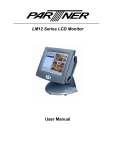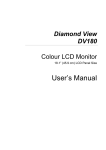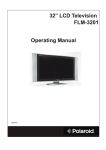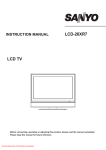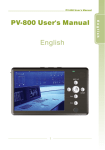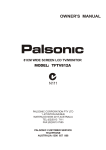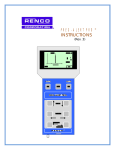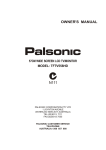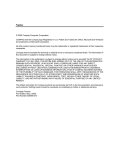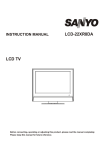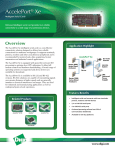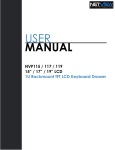Download Adjusting the Monitor - Mitsubishi Electric Australia
Transcript
Diamond View DV150 LCD Color Monitor 15.1” (38.35cm) LCD Panel Size User’s Manual Copyright Notice Copyright 1999, Mitsubishi Electric Australia Pty. Ltd. All rights reserved. No part of this publication may be reproduced, transmitted, transcribed, stored in a retrieval system or translated into any language or computer language, in any form or by any means, electronic, mechanical, magnetic, optical, chemical, manual or otherwise, without the prior written permission. Disclaimer Mitsubishi Electric Australia Pty. Ltd. makes no representations or warranties, either expressed or implied, with respect to the contents hereof and specifically disclaims any warranties, merchantability or fitness for any particular purpose. Further, Mitsubishi Electric Australia reserves the right to revise this publication and to make changes from time to time in the contents hereof without obligation to notify any person of such revision or changes. Fill in here!! For future reference, write the following information about your monitor in the space below. The serial number is on the back of the product or on the bottom of its stand. Monitor Information Product Name: DV 150 Serial Number: Date of Purchase: Dealer Information Dealer: Telephone Number: Address: ii iii Important Safety Instructions 1. The AC adaptor supplied with the DV150 monitor isolates it from the AC mains power supply. 2. Unplug the AC adaptor from the wall outlet before cleaning. Do not use liquid or aerosol cleaners. Use a soft cloth to clean the monitor housing and a tape to stick dust and fingerprints on the screen panel. 3. Slots and openings on the back or top of the cabinet are provided for ventilation. They must not be blocked or covered. This product should never be placed near or over a radiator or other heat source, or in a built-in installation unless proper ventilation is provided. 4. The DV150 monitor should only be operated with the AC adaptor model LE-9702B, manufactured by Lien Electronics. If you are not sure of the type of mains power available, consult your dealer or local Power Company. 5. Never push objects of any kind, or spill liquid of any kind into this product. 6. Do not attempt to service this product yourself as opening or removing covers may expose you to dangerous voltages or other risks. 7. If any abnormal operation or accident (such as dropping the unit) occurs, disconnect the monitor from the wall power outlet and contact qualified service personnel. iv Table of Contents Copyright Notice...................................... ii Disclaimer............................................ ii Important Safety Instructions......................... iv Table of Contents...................................... v Introduction........................................... 1 Unpacking the Package.............................. 1 Features........................................... 2 Power Management................................... 3 Getting Started........................................ 4 Installing the Monitor............................. 4 Adjusting the Monitor.................................. 5 A Look at the Control Panel........................ 5 Adjusting the Monitor.............................. 5 OSD(On-Screen Display) Operation Procedure..... 6 Contrast hot-key mode...................... 6 Brightness hot-key mode.................... 6 Main menu mode............................. 6 Making Adjustments............................. 7 Control Functions Available in Main Menu....... 7 Auto : automatically adjusts Color Temperature, Phase, V-Position, H-Position and Pixel Clock while the screen size is full................. 12 When Your Monitor Must Be Adjusted................ 13 How to Adjust Your Monitor using the Diskette. 13 Supported Timings................................. 14 Troubleshooting................................... 16 Maintenance....................................... 18 Need More Help?................................... 18 Specifications........................................ 19 Contacting Mitsubishi Electric........................ 20 Australia:........................................ 20 v Introduction 1 This chapter helps you check your pack and introduces the advantages of your new LCD Monitor. Unpacking the Package Check following items. If they are missing or damaged, consult your place of purchase immediately. 9 LCD monitor with attached signal cable 9 Power cord & adapter 9 User’s manual 9 Diskette Locate the model name and the serial number label on the back of your monitor or underneath its stand. Write down the details of your monitor and dealer in the space on page (ii) of this manual for future reference. 1 Features Your Diamond View DV150 has the following features: 9 Power Saving Function The power management complies with VESA DPMS standard. When the system is idle (in monitor off mode), the monitor automatically cuts its power consumption to less than 5W. 9 Plug’n Play Compatibility It is compatible with the Plug’n Play features of Windows® 95 and Windows® 98. 9 Space Saving Compared with CRT monitors, the depth of your LCD monitor footprint is only 170mm, reducing the required desktop space by at least 50%. 9 Light Weight Your monitor weights only 5.8Kg, almost 70% lighter than traditional 15” CRT monitors. 9 Lower Power Consumption Compared to the maximum 100W power consumption of 17” CRT monitors, this monitor consumes only 36W in operation (maximum). 9 Intelligent Screen Technology The On-Screen Display (OSD) allows you to adjust all settings simply with on-screen menus. 9 High Quality Ratiometric Expansion With any resolution within the monitor’s specified range, your Diamond View DV150 monitor can expand the image to full screen. 9 True Colour Display With dithering support, Diamond View DV150 monitor enhances the visual effect and offers you better image quality. 9 Auto Function With auto adjustment function, the Auto key can automatically adjust Color temperature, H-position, V-position, Pixel clock and Phase for you. 2 Power Management The monitor’s power management complies with VESA DPMS standard and can lower the power consumption of the monitor while it is not in use. To release the monitor from the power-saving condition, press any key on the computer’s keyboard. The power consumption at NORMAL and OFF modes is as follows. Mode Power Consumption Horizontal Sync. Vertical Sync. Power LED Normal Off < 36 W < 5 W ON OFF ON OFF Green Amber 3 Getting Started 2 This chapter helps you install your monitor. Installing the Monitor This monitor is equipped with an auto-sensing AC adaptor power supply for voltages of 100~240V AC, 50~60Hz. 1. Make sure that computer system turned off. the is 2. Plug the signal cable into the signal connector at the rear of PC. 3. Plug adapter output cable to the jack at the rear of LCD monitor and the power cord to the adapter. 4. Connect the power to power source. cord 5. Turn on the computer and the monitor. 4 Adjusting the Monitor 3 This chapter helps you adjust all the settings to perfection. A Look at the Control Panel Adjusting the Monitor There are 5 keys for user's control. The function of each is as follows: z Enter key : enters sub-menus or selects items z Exit key : goes back to main menus (auto save), or leaves OSD. z 3 / key : adjusts the parameter setting to a lower value or adjusts contrast setting. z 4 / key : adjusts the parameter setting to a higher value or adjusts brightness setting. z Auto : Automatically adjusts Colour Temperature, VPosition, Phase, H-Position and Pixel Clock. 5 OSD(On-Screen Display) Operation Procedure Contrast hot-key mode 1. Press 3/ 2. Press to enter contrast hot-key mode. 3or4to do the adjustments. Brightness hot-key mode 1. Press 2. Press 4/ to 3or4 to enter brightness hot-key mode. do the adjustments. Main menu mode Grouped by functions, the OSD offers 5 groups of functions in its Main Menu for making adjustments: Luminance, Geometry, Color adjustment, Recall and Miscellaneous. The following describes the contents of each function and how you can make the adjustments. 6 Making Adjustments 1. Press Enter or Exit to enter Main menu. 2. Press 3or4to locate the item you desire to change, then press Enter to go into the sub-menu. 3. Press3or4 to locate the function item, then press Enter and3or4to make the adjustment. 4. Press Exit to save the settings and go back to main menu. Control Functions Available in Main Menu 1. Luminance Press Enter to go into sub-menu, and press3or4 locate the function item. There are two items: to Contrast : adjust the difference between the light and dark areas. Brightness : adjust the brightness of the display. 7 2. Geometry Hor. (horizontal) Position: position of the display. adjusts the horizontal Ver. (vertical) Position: adjusts the vertical position of the display. Phase: adjusts the phase of pixel clock. It can improve the focus and stability of your screen as well. Pixel Clock: adjusts the frequency of the pixel. With this function, you can enlarge or reduce the width of your screen. 3. Color Adjustment 8 Color User Mode: Press Enter to press3or4to do adjustment. select Red adjustment G Green adjustment B Blue adjustment items. Then If you want to recall preset color, please locate color settings. R the to recall the preset Recall: recalls the preset color settings. 4. Recall Locate and press Enter, you can recall the preset settings. This page is also a “status display” field that shows current horizontal and vertical frequency status. If you set a timing that is not listed on the preset timing table, “Non Preset Mode” will be shown on this page. 9 5. Miscellaneous OSD Position Hor. (horizontal) Position: adjusts OSD horizontal position. Ver. (vertical) Position: adjusts OSD vertical position. ABC Language Select De: Deutsche Fr: Français En: English It: Italiano 10 Es: Español Ja: Japanese 11 Color Palette 256K: supports up to 262,144 colors. 16M: supports up to 16,777,216 colors with dithering technology. Auto : automatically adjusts Color Temperature, Phase, VPosition, H-Position and Pixel Clock while the screen size is full. ) To Automatically adjust the image, you may use the program on the accompanying diskette (Auto.exe) which contains a test pattern that is used to optimise your image settings. Please run the file and then press Auto key, the screen will be automatically adjusted to optimum image. This pattern is compatible with Windows 95 and Windows 98. 12 ) If “Non Preset Mode” appears on the OSD, it means that the graphics card has set an unacceptable timing. Please refer to the table of supported timings on the next page and set the graphics card to use a preset timing. When Your Monitor Must Be Adjusted z z z z If the resolution or refresh rate is changed If the graphic card is changed If the PC is changed After using the “Recall” function How to Adjust Your Monitor using the Diskette Using the test pattern on the diskette, you can easily optimize your screen performance. Steps: 1.Insert the diskette and display the test pattern by running A:\auto.exe 2.Press the Auto key for automatic adjustment. To manually fine tune the settings: 3.Press Enter to open the OSD menu. 4.Using the pattern, adjust the OSD controls to reach your desired brightness, contrast, etc. 5.Select Geometry icon. 6.Select Pixel Clock function to adjust the value to minimize vertical bars. 7.Select Phase function minimize horizontal bars. 8.Select Horizontal Position adjust screen position. to adjust the value and Vertical Position to to 9.Press Exit button to save the changes. 10. Press the left mouse button to exit the program and then click “Exit”. 13 Supported Timings Input display data Resolution H. Frequency V. Frequency (kHz) (Hz) Multi-scan operation Dot Clock Frequency (MHz) Remark Actual display resolution 1024x675 640 x 350 31.47(P) 70.08(N) 25.17 DOS ∗720 x 400 31.47(N) 70.08(P) 28.32 DOS ∗640 x 480 35.00(N) 67.00(N) 30.24 Macintosh ∗640 x 480 31.47(N) 60.00(N) 25.18 DOS 640 x 480 37.86(N) 72.80 (N) 31.5 VESA *640 x 480 37.50(N) 75.00(N) 31.5 VESA 800 x 600 35.16(P) 56.25(P) 36.00 VESA 800 x 600 37.88(P) 60.32(P) 40.00 VESA 800 x 600 48.08(P) 72.19(P) 50.00 VESA ∗800 x 600 46.87(P) 75.00(P) 49.5 VESA ∗832 x 624 49.72(N) 74.55(N) 57.29 Macintosh ∗1024 x 768 48.36(N) 60.00(N) 65.00 VESA ∗1024 x 768 56.48(N) 70.10(N) 75.00 VESA ∗1024 x 768 60.02(P) 75.00(P) 78.75 VESA ∗1024 x 768 60.24(N) 74.93(N) 80.00 Macintosh full screen 1024 x 768 Resolutions marked with * are in the factory preset timings. ) Timings not shown in the above table may not be supported. We recommend that you set the graphics card to use the factory preset timings to have optimum screen image. ) There are 15 modes that are compatible with VESA standards, Windows 95, 98 and NT, and the Apple Macintosh. 14 ) In some rare cases, the screen may show a small amount of noise. This may be caused by non-standard signal frequencies from the VGA card. It is not a defect. You can improve it by automatic adjustment or by manually adjusting the Clock Phase and Pixel Frequency in the image menu. ) When shutting down the computer system or turning off the monitor, some interference lines may appear on your screen. This is a normal situation. ) To extend the product life, we suggest you use the power saving function of your computer system. 15 Troubleshooting and Useful Hints 4 This chapter offers you some common solutions should you encounter problems. Troubleshooting Make sure that your monitor is properly installed if you have encountered any trouble using this product (For hardware installation, see Chapter 2, Getting Started). If the problems persist, check this chapter for possible solutions. 9 If there is no picture on the screen, check: Power saving mode. Press any key and move the mouse to reactivate the computer. Signal cable connector pins. If there are bent or missing pins, consult your place of purchase. 9 If the picture is unstable, check: Signal cable connector pins. If there are bent or missing pins, consult your place of purchase. Graphics card. See if the settings are made properly. Scanning frequency. Change the settings of your graphics signals. card to one of the monitor’s preset Monitor adjustments. See Chapter 3, Adjusting the Monitor, particularly procedure. 16 the automatic adjustment 9 Characters look too dark or too light. Adjust related settings. See Chapter 3, Adjusting the Monitor. 17 Maintenance 8 8 8 8 8 8 Do not expose the monitor to direct sunlight or heat. Do not spill liquid on the monitor or AC adaptor. Do not attempt to open the monitor. You may be hurt by electric shock. For service, call your place of purchase. Disconnect the monitor’s AC adaptor from the wall socket before cleaning. Do not use harsh chemicals or strong cleaning solvents to clean the monitor screen. Wipe it with clean, soft cloth with mild cleaning solution. Do not place anything on your monitor or AC adaptor. Bad ventilation may elevate temperature in the unit and cause damage to it. Need More Help? If your problems remain after checking this manual, please contact your place of purchase. Driver files and product information is available from Mitsubishi Electric Australia’s web site at http://www.mitsubishi-electric.com.au 18 Specifications 5 This chapter offers you basic information about your Monitor. LCD Panel 15.1”, active matrix TFT Power Supply (Universal) 90~264 V AC, 47~63 Hz Input voltage 36W max. Power consumption 1024 x 768 pixels Max. Resolution Video Input RGB input User’s Control Power ON/OFF, OSD Regulatory Compliance C-Tick (AS3548), AS3260, CE, TCO’99(Optional) 307.2mm (H) X 230.4mm (V) Display Area Ambient Temperature Operating Storage +5°C ~ +40°C / +41°F ~ +104°F -20°C ~ +60°C / -4°F ~ +140°F Humidity Operating Storage 20% ~ 85% 10% ~ 85% Dimensions (W x H x D) 390 mm x 361 mm x 170 mm Weight (net) 5.8 Kg 19 6 Contacting Mitsubishi Electric Australia: Address: Mitsubishi Electric Australia Pty. Ltd. 348 Victoria Road, Rydalmere, NSW, 2116 Telephone: (02) 9684-7777 Fax: (02) 9898-0484 Web site: http://www.mitsubishi-electric.com.au New Zealand: Contact information for MELCO New Zealand is: Address: MELCO New Zealand Ltd. 1 Parliament Street, Lower Hutt Telephone: (04) 560-9100 Fax: (04) 560-9140 Web site: http://www.melco.co.nz 20



























